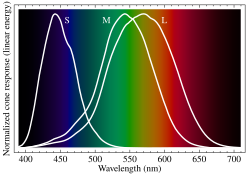
Back خلية مخروطية Arabic Kolbacıqlar Azerbaijani Čepićasta ćelija BS Con (cèl·lula) Catalan خانەی قووچەکی CKB Čípek (oko) Czech Tap (synet) Danish Zapfen (Auge) German Κωνία Greek Konuseto Esperanto
| Cone cells | |
|---|---|
 Normalized responsivity spectra of human cone cells, S, M, and L types | |
| Details | |
| Location | Retina of vertebrates |
| Function | Color vision |
| Identifiers | |
| MeSH | D017949 |
| NeuroLex ID | sao1103104164 |
| TH | H3.11.08.3.01046 |
| FMA | 67748 |
| Anatomical terms of neuroanatomy | |
Cone cells or cones are photoreceptor cells in the retina of the vertebrate eye. Cones are active in daylight conditions and enable Photopic vision, as opposed to rod cells, which are active in dim light and enable Scotopic vision. Most vertebrates (including humans) have several classes of cones, each sensitive to a different part of the visible spectrums of light. The comparison of the responses of different cone cell classes enables color vision. There are about six to seven million cones in a human eye (vs ~92 million rods), with the highest concentration occurring towards the macula and most densely packed in the fovea centralis, a 0.3 mm diameter rod-free area with very thin, densely packed cones. Conversely, like rods, they are absent from the optic disc, contributing to the blind spot.[1]
Cones are less sensitive to light than the rod cells in the retina (which support vision at low light levels), but allow the perception of color. They are also able to perceive finer detail and more rapid changes in images because their response times to stimuli are faster than those of rods.[2] In humans, cones are normally one of three types: S-cones, M-cones and L-cones, with each type bearing a different opsin: OPN1SW, OPN1MW, and OPN1LW respectively. These cones are sensitive to visible wavelengths of light that correspond to short-wavelength, medium-wavelength and longer-wavelength light respectively.[3] Because humans usually have three kinds of cones with different photopsins, which have different response curves and thus respond to variation in color in different ways, humans have trichromatic vision. Being color blind can change this, and there have been some verified reports of people with four types of cones, giving them tetrachromatic vision.[4][5][6] The three pigments responsible for detecting light have been shown to vary in their exact chemical composition due to genetic mutation; different individuals will have cones with different color sensitivity.
- ^ "The Rods and Cones of the Human Eye". HyperPhysics Concepts - Georgia State University.
- ^ Kandel, E.R.; Schwartz, J.H; Jessell, T. M. (2000). Principles of Neural Science (4th ed.). New York: McGraw-Hill. pp. 507–513. ISBN 9780838577011.
- ^ Schacter, Gilbert, Wegner, "Psychology", New York: Worth Publishers,2009.
- ^ Jameson, K. A.; Highnote, S. M. & Wasserman, L. M. (2001). "Richer color experience in observers with multiple photopigment opsin genes" (PDF). Psychonomic Bulletin and Review. 8 (2): 244–261. doi:10.3758/BF03196159. PMID 11495112. S2CID 2389566.
- ^ "You won't believe your eyes: The mysteries of sight revealed". The Independent. 7 March 2007. Archived from the original on 6 July 2008. Retrieved 22 August 2009.
Equipped with four receptors instead of three, Mrs M - an English social worker, and the first known human "tetrachromat" - sees rare subtleties of colour.
- ^ Mark Roth (September 13, 2006). "Some women may see 100,000,000 colors, thanks to their genes". Pittsburgh Post-Gazette. Archived from the original on November 8, 2006. Retrieved August 22, 2009.
A tetrachromat is a woman who can see four distinct ranges of color, instead of the three that most of us live with.